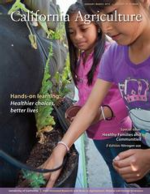
Original research and literature reviews on these subjects appear in the January-March 2013 California Agriculture, UC’s peer-reviewed research journal of research in agriculture, natural and human resources (http://www.californiaagriculture.ucanr.edu).
UC Agriculture and Natural Resources (ANR) has launched a strategic initiative to help California youth. Called Healthy Families and Communities, it includes research and programs to encourage healthy lifestyles, boost science literacy, and foster positive youth development. Delaine Eastin, former State Superintendent of Public Instruction, notes, “At the end of the day, the Healthy Families and Communities Strategic Initiative is about change, scientifically measurable change, yielding concrete evidence of youth improvement due to these efforts.”

In addition, each year about 100,000 California youth who reach graduation age fail to graduate from high school, a predictor of their future social and financial difficulties as well as a missed opportunity for training skilled workers to replace those close to retirement. Finally, California’s eighth-grade science scores ranked 47th among the states in the National Assessment of Educational Progress’s 2011 report. A workforce with the knowledge and skills for scientific careers is critical to the state’s economy, and to full participation in today’s technological society.
Confronting these complex issues requires a multifaceted approach that leads to strategic change, says David Campbell, UC Cooperative Extension specialist in the Department of Human and Community Development at UC Davis and leader of ANR’s new youth-focused initiative.
“We’re bringing a lot of people together across disciplines,” he says. “If our work is going to be relevant to the real world, we need to reflect its complexity.”
As part of the initiative, UC researchers are partnering with schools and youth organizations in controlled studies to learn what works in the real world.
Summaries of projects and links to articles:
Integrating local agriculture into nutrition programs can benefit children's health (page 30). Sheri Zidenberg-Cherr, UCCE specialist in the Department of Nutrition at UC Davis, leads a K-6 nutrition education effort, called Shaping Healthy Choices. Designed to both improve child health and support local agriculture, the program incorporates serving regional fruits and vegetables, a school garden, and classroom nutrition and physical fitness lessons. In this controlled four-year study, investigators have matched schools in Northern and Central California, and will compare those that are implementing the program with those that are not.
Communitywide strategies key to preventing childhood obesity (page 13). According to Pat Crawford, UCCE specialist in the Department of Nutritional Science and Toxicology at UC Berkeley, increasing consumption of fruits and vegetables is important but not enough by itself to combat obesity. Two of the strongest factors driving obesity are sweetened beverages and fast food, and decreasing their consumption is just as important as increasing the consumption of healthy foods. “You have to do both,” she says.
Her team at the Center for Weight and Health in Berkeley, with funding from ANR, is evaluating Team Up for Good Health, a community-based approach to preventing obesity in elementary school children. Investigators are studying fourth- and fifth-grade participants in school and after-school obesity prevention programs, using body mass index (BMI) reductions after two years as a measure of success.
Lessons of Fresh Start can guide schools seeking to boost student fruit consumption (page 21). In 2005, California became the first state to address the availability of fresh and local produce in the federal School Breakfast Program through state funding. This evaluation of the California Fresh Start program reveals lessons that are especially important now, as schools across the country prepare to increase the number of fruits and vegetables offered in the School Breakfast Program by July 2014 as part of the Healthy, Hunger-Free Kids Act.
Inquiry-based learning (pages 47 and 54). Another innovative aspect of these UC programs is the curriculum. Based upon inquiry-based learning, it captures the attention of students by focusing on the real world and children’s day-to-day lives. For example, in the Shaping Healthy Choices program (page 30), a lesson on food labels at school will be followed by students comparing food labels on their own, at home and in grocery stores. “Application is what makes learning stick,” says Martin Smith, UCCE specialist in the School of Veterinary Medicine who works on youth science literacy. “Inquiry-based learning takes longer, but it’s deeper — kids own the knowledge because they figured it out themselves.”
Positive youth development merits state investment (page 38). A team of UC researchers reviews studies supporting a new paradigm for youth programs, and proposes increased state investment in this area. Research over the last 30 years has shifted thinking away from the deficit model, in which researchers and practitioners considered high-risk youth behaviors to be their focus, and toward promotion of positive patterns. “Far too many California youth are not thriving,” the authors note. “Promotion of healthy pathways to college, work and community engagement is of urgent concern.” They cite findings that positive youth development is linked to improved school achievement, higher graduation rates, and fewer risk behaviors.
The entire January-March 2013 issue can be downloaded at http://californiaagriculture.ucanr.edu.
California Agriculture is the University of California’s peer-reviewed journal of research in agricultural, human and natural resources. For a free subscription, go to: http://californiaagriculture.ucanr.edu, or write to calag@ucanr.edu.
WRITERS/EDITORS: To request a hard copy of the journal, e-mail crllopez@ucanr.edu.